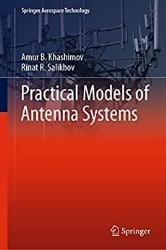Practical Models of Antenna Systems
- Добавил: literator
- Дата: 22-11-2022, 08:45
- Комментариев: 0
 Название: Practical Models of Antenna Systems
Название: Practical Models of Antenna Systems Автор: Amur B. Khashimov, Rinat R. Salikhov
Издательство: Springer
Год: 2022
Страниц: 130
Язык: английский
Формат: pdf (true)
Размер: 10.3 MB
This book discusses the principles of forming and analysis of mathematical models of a wide class of antenna systems, new scientific directions in the development and application of computational algorithms for the study of mathematical models for antenna arrays of radio navigating systems. The book is presented for specialists in antenna system design; it may be useful for students of radio engineering specialties. This book consequentially uses the asymptotic correspondence of two-dimensional and three-dimensional problems to antenna engineering, that includes the influence of the placement objects for a given limited class of problems. Rigorous electrodynamics formulations of models and the use of efficient numerical methods provide the reliability and accuracy of modeling.
Mathematical modeling occupies an important place in the design of antenna systems. This is due to a significant complication of the structure of antenna systems and their functional characteristics, primarily for phased antenna arrays, where the issues of mutual influence of radiators should be considered both for a given frequency band and in the scanning sector, taking into account polarization characteristics. This leads to the need to use mathematical models of real radiators of antenna systems, built on the basis of strict electrodynamic relationships and taking into account the installation object. In this case, the developers of antenna systems have the possibility of a detailed analysis of the electromagnetic radiation field of antenna systems and the synthesis of corrective functions of the amplitude-phase distribution to compensate for the influence.
Particular attention in the practice of mathematical modeling of complex antenna systems is given to the reliability of the results obtained. Therefore, the main results presented in the book have undergone a detailed verification by solving test problems that admit a rigorous analytical solution. At the same time, it should be noted that such solutions are most often represented as infinite Fourier series in special functions, the calculation of which, in turn, is associated with certain errors. Consequently, a slight discrepancy between the results of analytical and numerical results of the study of mathematical models is often associated not only with the approximation and discretization of a real electrodynamic problem but also with approximations of finite series, especially in the field of asymptotic estimates of special functions. Therefore, a high degree of agreement between numerical results and analytical solutions indicates the reliability of mathematical models and the possibility of their use in the design of antenna systems. In the absence of rigorous analytical solutions to the corresponding boundary value problems, one of the ways to verify the results obtained is an experimental study of the developed antenna system. It is important that antenna measurements have their own specific features, but the qualitative agreement of the results is also a criterion for the adequacy of mathematical models. It should also be noted here that numerous variants of antenna systems developed using the mathematical models proposed by the authors have received appropriate experimental confirmation.
The materials of the book may be useful to developers of antenna systems and students of radio engineering specialties.
Скачать Practical Models of Antenna Systems
Внимание
Уважаемый посетитель, Вы зашли на сайт как незарегистрированный пользователь.
Мы рекомендуем Вам зарегистрироваться либо войти на сайт под своим именем.
Уважаемый посетитель, Вы зашли на сайт как незарегистрированный пользователь.
Мы рекомендуем Вам зарегистрироваться либо войти на сайт под своим именем.
Информация
Посетители, находящиеся в группе Гости, не могут оставлять комментарии к данной публикации.
Посетители, находящиеся в группе Гости, не могут оставлять комментарии к данной публикации.
